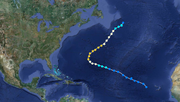The 2019 Atlantic hurricane season was a catastrophic hurricane season. The Great Hurricane of New York City, also known as Hurricane Iris was a rare, fatal hurricane. It's size was 735 miles in diameter, smaller then Sandy, but extreme. It caused $114 billion dollars of damage. The type of Hurricanes that slams in New York can happen every 10 years. This hurricane caused low damage to Canada and did Moderate Damage to Maine. The way this hurricane formed is unknown.
Storms[]
Subtropical Storm Aaron[]
| Subtropical storm (SSHWS) | |
| Duration | June 5, 2019 – June 8, 2019 |
|---|---|
| Peak intensity | 85 km/h (55 mph) (1-min) 1000 hPa (mbar) |
Aaron was a rapid, short lived, weak subtropical storm, that barely caused any damage or fatalities.
Tropical Storm Bertha[]
| Tropical storm (SSHWS) | |
| Duration | June 6, 2019 – June 11, 2019 |
|---|---|
| Peak intensity | 95 km/h (60 mph) (1-min) 996 hPa (mbar) |
Bertha was a weak tropical storm, that affected Cuba, Mexico, Belize, Texas and Louisiana. There were no fatalities reported, but 3 people went missing due to storm surge.
Hurricane Croyt[]
| Category 1 tropical cyclone (SSHWS) | |
| Duration | June 10, 2019 – June 17, 2019 |
|---|---|
| Peak intensity | 120 km/h (75 mph) (1-min) 991 hPa (mbar) |

Croyt was a short-lived hurricane. Since the areas the hurricane was going through was unfavorable, it only strengthened to a Category 1 storm. It dissipated near the Florida coast.
Subtropical Storm Dale[]
| Subtropical storm (SSHWS) | |
| Duration | June 13, 2019 – June 15, 2019 |
|---|---|
| Peak intensity | 75 km/h (45 mph) (1-min) 999 hPa (mbar) |
Dale was the shortest lived storm. It only affected the Florida Big Bend and was a subtropical storm. It didn't even make through the Florida state, and the storm was 30 miles long.

Hurricane Emma[]
| Category 3 tropical cyclone (SSHWS) | |
| Duration | June 19, 2019 – June 28, 2019 |
|---|---|
| Peak intensity | 185 km/h (115 mph) (1-min) 960 hPa (mbar) |

Track of Emma
In June 19, Emma formed due to a disturbance near the Lesser Antilles. It was a Category 1 and 2 storm near Jamaica. It then struck Cuba as a Category 3 hurricane. It then quickly weaked and turned to the left, affecting Key West and Southern Florida. It then moved on to Louisiana and Alabama as a weak Tropical Storm, suddenly dissipaiting into a Depression.
Hurricane Fabian[]
| Category 3 tropical cyclone (SSHWS) | |
| Duration | June 30, 2019 – July 11, 2019 |
|---|---|
| Peak intensity | 190 km/h (120 mph) (1-min) |

Track of Fabian
When there was a disturbance that formed Emma, it split, and formed the 6th depression. It took a while and was a Tropical Storm. This was one of the most common Cape-Verde type hurricanes. It strengthened towards Category 3 status. Since the storm affected North Carolina, 5 were dead and 17 missing. it weakened into a Tropical Storm. It affected New Brunswick and Nova Scotia, 3 went missing, and it struck Newfoundland as a Tropical Depression. No fatalities were recorded in Newfoundland. The storm dissipated 22 hours after striking Newfoundland.
Hurricane Gabriel[]
| Category 4 tropical cyclone (SSHWS) | |
| Duration | July 11, 2019 – July 20, 2019 |
|---|---|
| Peak intensity | 215 km/h (135 mph) (1-min) 935 hPa (mbar) |
Gabriel formed nearly the same area of Fabian. This depression quickly strengthened to a Tropical Storm and then to a Category 1 hurricane. It rapidly intensified to a Category 2 hurricane. It briefly became Category 3, and was upgraded to Category 4 status and storm surge was intense near Bermuda. It weaked rapidly and dissipated.

Track of Gabriel
Hurricane Hank[]
| Category 3 tropical cyclone (SSHWS) | |
| Duration | July 21, 2019 – July 30, 2019 |
|---|---|
| Peak intensity | 205 km/h (125 mph) (1-min) 953 hPa (mbar) |
When this hurricane formed, it went straight up. People thought it would be a normal hurricane such as Gabriel and Fabian. It reached Category 2 status quickly. The people still thought it would move away from North Carolina. When it reached Category 3 status, the idea was doubted and it struck North Carolina as a very strong Category 3 hurricane, carrying lots of water and had a large hurricane in diameter. 232 people died because most were unprepared. Storm surge was 13 feet high. After 27 hours, it weaked to a Category 2 hurricane. New England was prepared and 22 people died. In Canada in Nova Scotia, New Brunswick, and Newfoundland, 12 fatalities were recorded.

The Hurricane of North Carolina.
Subdepression 09[]
| Subtropical depression (SSHWS) | |
| Duration | August 5, 2019 – August 7, 2019 |
|---|---|
| Peak intensity | 45 km/h (30 mph) (1-min) 1008 hPa (mbar) |
Great Hurricane of New York City (Hurricane Iris)[]
| Category 5 hurricane (SSHWS) | |
| Duration | August 5, 2019 – August 16, 2013 |
|---|---|
| Peak intensity | 190 mph (305 km/h) (1-min) 884 mbar (hPa) |
In August 5, there was lots of rain in Africa for an unknown reason. It moved to the sea were i

The Great Hurricane of NYC caused significant damage to New York, Rhode Island, and other states close to NY.
t got more strength and turned to a Tropical Depression. It then intensified to a Tropical Storm and quicky turned to a Category 1. Very rapidly, it was a major hurricane under 14 hours. It reached Category 5 status, when most Cape-Verde type hurricanes don't have this pontential (The last hurricane that has done this was in 1938, New England Hurricane.) It sustained Category 5 for a very long time for 3 days. It was aiming for New York, the Jet stream was too weak to push it to the right side. It hit New York as a Category 5 hurricane and was 160 mph. It very rapidly weaked into a Category 4 and was 155 mph. Storm surge went up as much as 32 feet. 7,259 fatalities and 233 went missing. It affected New England alot, but New York the most. It hit Michigan as a Category 2 hurricane, causing an extra 22 fatalities. It then hit Ontario causing unsual flooding from a Tropical Depression. It turned Extratopical and hit Quebec, however, the track cannot show this as it has too little space. It then dissipated on August 16.
Subtropical Storm Jade[]
| Subtropical storm (SSHWS) | |
| Duration | August 6, 2019 – Aygust 8, 2019 |
|---|---|
| Peak intensity | 65 km/h (40 mph) (1-min) 996 hPa (mbar) |
Tropical Storm Kale[]
| Tropical storm (SSHWS) | |
| Duration | August 18, 2019 – August 22, 2019 |
|---|---|
| Peak intensity | 75 km/h (45 mph) (1-min) |

Track of Kale
Hurricane Landon[]
| Category 2 tropical cyclone (SSHWS) | |
| Duration | August 25, 2019 – September 1, 2019 |
|---|---|
| Peak intensity | 155 km/h (100 mph) (1-min) 974 hPa (mbar) |

Track of Landon, 1 went missing due to storm surge in Bermuda.
Hurricane Maddox[]
| Category 3 tropical cyclone (SSHWS) | |
| Duration | September 4, 2019 – September 16, 2019 |
|---|---|
| Peak intensity | 195 km/h (120 mph) (1-min) 940 hPa (mbar) |
Hurricane Nathan[]
| Category 3 tropical cyclone (SSHWS) | |
| Duration | September 13, 2019 – September 26, 2019 |
|---|---|
| Peak intensity | 185 km/h (115 mph) (1-min) 945 hPa (mbar) |
Hurricane Oliver[]
| Category 5 tropical cyclone (SSHWS) | |
| Duration | October 5, 2013 – October 15, 2019 |
|---|---|
| Peak intensity | 255 km/h (160 mph) (1-min) 910 hPa (mbar) |
Tropical Storm Patrick[]
| Tropical storm (SSHWS) | |
| Duration | October 19, 2019 – October 25, 2019 |
|---|---|
| Peak intensity | 110 km/h (70 mph) (1-min) 995 hPa (mbar) |
Subtropical Depression Eighteen[]
| Subtropical depression (SSHWS) | |
| Duration | November 3, 2019 – November 5, 2019 |
|---|---|
| Peak intensity | 55 km/h (35 mph) (1-min) 1000 hPa (mbar) |
Timeline[]









